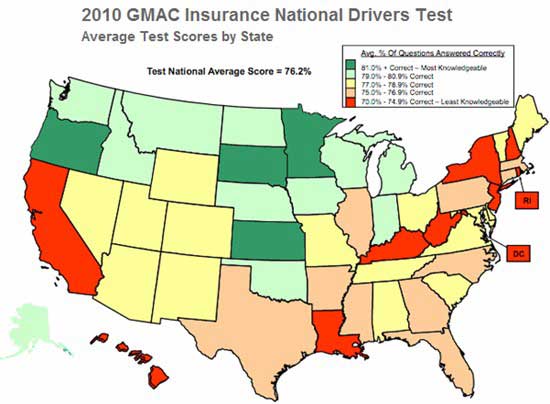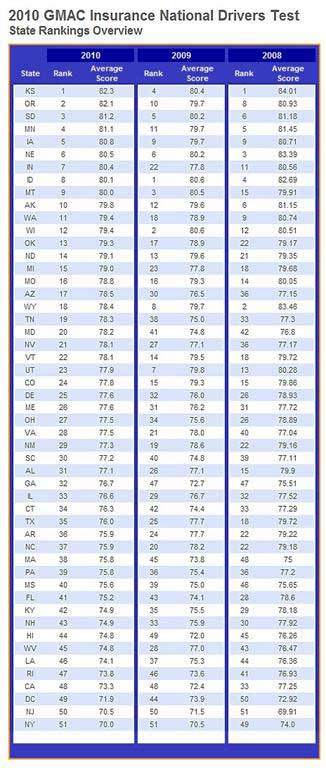Roughly 38 million Americans—or 18.4% of drivers on the road—would not pass a written drivers test exam if they were to take one today, according to results of 2010 GMAC Insurance National Drivers Test.
The average national exam score was 76.2% in 2010, down nearly 2 points from the 78.1% scored in 2008. Any score below 70% is considered failing.

Drivers in the Northeast are not as road-rule savvy as their Midwestern counterparts: The Northeast had the lowest average test scores (74.9%) and had the highest failure rate (25.1%), whereas the Midwest region had the highest average test scores (77.5%) and the lowest failure rates (11.9%).
Below, other results of the GMAC Insurance National Drivers Survey.
Most Knowledgeable Drivers in Kansas, Least in New York
After dropping to fourth place last year from its No. 1 ranking in 2008, Kansas regained the top spot this year with an average driving exam score of 82.3%. New York drivers ranked last for the third time in the survey's six-year history (70.0%).

Other regional findings:
- Ranked in the top 4 this year are Kansas, Oregon, South Dakota, and Minnesota; Washington DC, California, New York, and New Jersey ranked in the bottom 4.
- Both New York and New Jersey have ranked in the bottom 4 for the last five years.
- New Jersey claims the top failure ranking in 2010 with virtually 4 out of 10 New Jersey drivers (39.9% ) scoring below 70%, followed by New York, DC, and Louisiana—all with failing scores of 31% or higher.
- Wisconsin, which tied with Idaho for the best score last year, dropped to No. 12 this year, although its average test score fell just a little over 1% from 80.6% down to 79.4%.
- South Dakota and Oregon rank No. 1 and No. 2 with the highest percentage of passing scores (92% and 91%, respectively).
The average test score was higher among men (78.1%) than women (74.4%). Women also had a higher failure rate (24.0%) than men (18.1).
Men age 45+ earned the highest average test score.
Looking for great digital marketing data? MarketingProfs reviewed hundreds of research sources to create our most recent Digital Marketing Factbook (May 2010), a 296-page compilation of data and 254 charts, covering email marketing, social media, search engine marketing, e-commerce, and mobile marketing. Also check out The State of Social Media Marketing, a 240-page original research report from MarketingProfs.
Driving Distractions
Conversation with other passengers is the leading distraction while driving, cited by 52% of surveyed drivers.
Roughly 25% of drivers say they drive while talking on a cell phone, eating and adjusting the radio, or selecting songs on an iPod.
Some 5% say they text while driving.
Overall, a significantly higher percentage of females than males reported engaging in the following distracting situations: conversation with passengers, selecting songs on an iPod or CD, adjusting the radio, talking on a cell phone, eating, applying make-up, and reading.
"It's discouraging to see that overall average test scores are lower than last year," said Wade Bontrager, senior vice-president, GMAC Insurance. "American drivers need to make safety a top priority and be aware of the rules of the road at all times. The National Drivers Test allows everyone to brush up on their driving knowledge with a brief refresher course."
About the data: The sixth annual GMAC Insurance National Drivers Test surveyed 5,202 licensed Americans from 50 states and the District of Columbia, gauging driver knowledge by administering 20 questions taken from state Department of Motor Vehicles (DMV) exams. Additional questions explored distracting habits such as texting while driving. The study was conducted by TNS.



